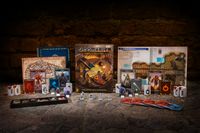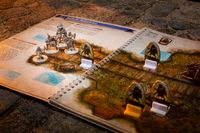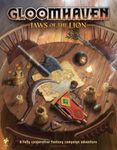Though it is bigger than most game boxes, Gloomhaven: Jaws of the Lion still feels small. This is, of course, due to the fact that one naturally compares it to its predecessor, Gloomhaven, the giant box of cardboard that stole this website’s heart three years ago.
And while Gloomhaven may be a critical darling here among the hardcore gamers, I couldn’t help but wonder what a version of Gloomhaven that appeals to a more mainstream audience would look like. Well, turns out that it would look a lot like Jaws of the Lion.
I dabbled briefly with the idea that a mainstream version of Gloomhaven would be a completely different game. I designed a simple card game that had some of the same concepts — dungeon delving, leveling up, and retiring — in which completing a scenario was as simple as matching the icons on the dungeon to the icons on your adventuring party. It…wasn’t great.
Meanwhile, I’d demo Gloomhaven at conventions, I’d demo it for friends and family, and no matter who I dropped a hand of cards in front of, with proper explanation, they’d be able to play their character and have fun. The core mechanisms of Gloomhaven — play two cards from your hand and perform the top action of one and the bottom action of the other — were solid. I realized there was no need to change that.
I just needed to change all the stuff around it that made it intimidating and hard to get into, things like:
• The giant box
• The large price tag
• The hard-to-organize horde of components
• The difficult-to-penetrate rules
• The overly difficult first scenario
• The lengthy set-up time
I just needed to fix all of these issues while leaving the core gameplay intact. It turned out to not be such an easy task. A lot of these things go hand-in-hand, though. For instance, if you reduce the number of components, you reduce the box size, and you reduce the price, so let’s start there.
The first thing that needed to happen was to reduce the amount of content in the box, reduce the number of scenarios, the number of monsters, and the number of characters. Gloomhaven was built on the dream of a huge, open-world campaign, but Jaws of the Lion didn’t have that luxury. It would be a simpler campaign (told entirely within the city of Gloomhaven to reduce the size of the map) that focused on a single set of four characters. There would be no retirement or switching of characters. The campaign would be just long enough for a player go on an adventure with a single character class and still not be bored by the end.
But even after a reduction of content, there were a lot of components in this box. In particular, creating varied scenarios requires lots of different cardboard map tiles and overlay tiles — that is, it did until I managed to cut all of those components by translating the play area for the scenarios into the scenario book itself. Instead of the book telling you how to set up the map tiles, the book was the map tiles.
This implementation was challenging because I had to wrestle a standard book of 8.5″x11″ pages into a play surface for grand and expansive scenario ideas. There were limitations on the layout due to the spiral binding in the middle of the page, but adding a supplementary book that attached onto a two-page spread in the main book opened up the design space enough to create plenty of interesting and unique scenarios. Plus it allowed for the creation of custom art for each scenario in the game, which was very cool and very rewarding — though the artist, David Demaret, did put in a lot of long hours to get everything done on time!
Playing in the book itself also solved one of the other main problems: the set-up time. Being able to open the book, drop some monsters and characters onto it, and start going was a huge boon to the system as well. This was also aided by additional organizational tools in the box such as the token tray to hold all the little bits.
With the content pared down, organized, and presented compactly in the scenario book, the last and most difficult hurdle was making the rules easier to learn. I wanted to create a tutorial system to ease people into the system slowly, and I also needed to cut some of the more complicated aspects that would get in the way of learning the system.
The biggest part of the rules to cut out was most of the campaign elements. As stated above, this game has no retirement, but it also doesn’t have prosperity, reputation, or temple donations. I wanted to keep city events, but since the campaign was entirely set within the city, road events didn’t make any sense.
There were also a bunch of little things to cut: summoning, retaliate, rolling modifiers, complicated monster focus tie-breakers. Basically, I had a development weekend, sat down with a group of people very familiar with the game, and hashed out which aspects of the game possibly cause more confusion than they are worth. It was hard to cut things away from something I loved, but in the end, I think we were able to throw out the bathwater and keep the baby.
And then I had to make the tutorial. Initially I thought I could on-board new players in three scenarios. There was a simple starting scenario, then a short boss fight, then scenario three was basically full Gloomhaven. Over that development weekend, though, I was eventually convinced that five scenarios minimum would be needed, so we set about doing that.
We brainstormed all the separate concepts in the game, then tried to group them together in the most logical, consistent way so that each scenario introduced a new group of concepts that made sense and wasn’t too overwhelming.
Starting the game with a limited set of concepts, however, also limited what you could do with the ability cards at the start, so I decided to create basic starting cards that evolved and were upgraded as new concepts were introduced. When you’re heavily concerned with reducing components, it was rough to add a bunch of cards used only in a handful of scenarios, but ultimately I think it was the right call. Making the game easy to learn was the highest priority.
Once the five scenarios were put together and the first draft of the tutorial guide was written, the next step was to playtest and rewrite over and over and over, putting it in front of groups who had never played Gloomhaven and watching how they interacted with the guide and the game. It was a long process, but eventually it got to a place where I was confident that nothing in the game would hang up new players.
Ultimately, I started the project thinking that making a simple version of Gloomhaven would be a simple thing, but it turned into a much more complicated beast than I anticipated. Still, I am happy with the result, and as much as I hope you are as well, what I really hope is that new, more casual gamers will also be happy with their experience with the game!
The post Designer Diary: Gloomhaven: Jaws of the Lion, or Throwing out the Bathwater and Keeping the Baby appeared first on FanFareGames.
from https://boardgamegeek.com/blogpost/105732/designer-diary-gloomhaven-jaws-lion-or-throwing-ou
from
https://fanfaregames.tumblr.com/post/621685293532233728
from https://darlenehicks.blogspot.com/2020/06/designer-diary-gloomhaven-jaws-of-lion.html
from
https://darlenehicks.tumblr.com/post/621690827767480320





No comments:
Post a Comment